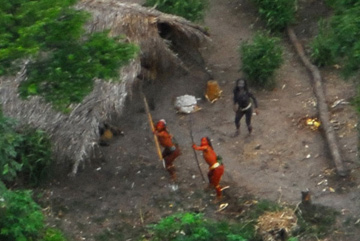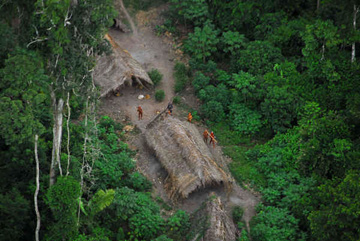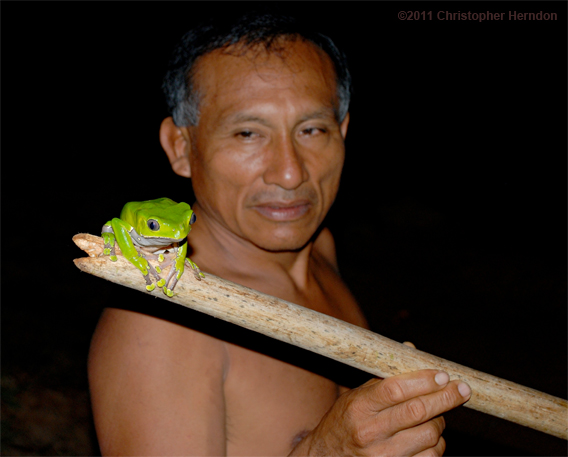
Mark Plotkin speaking at TED Global in October in Brazil.
If you have ever wondered about the connection between giant hallucinogenic frogs, uncontacted peoples, conservation, and climate change — and who hasn’t? — check out this TED talk from ethnobotanist Mark Plotkin: What the people of the Amazon know that you don’t.
An ethnobotanist by training, Plotkin serves as President of the Amazon Conservation Team (ACT). The evening before Thanksgiving, Plotkin took a few minutes from his busy schedule to answer a few questions from Mongabay.
AN INTERVIEW WITH MARK PLOTKIN.
Mongabay.com: In your talk, you note a saying, “rainforests hold answers questions to questions we have yet to ask.” Is your feeling that society is finally starting to ask those questions or at least better recognize the value of healthy ecosystems?
Mark Plotkin: That so many people are so interested in shamanic ways of knowing and healing, that so many people drift down to Iquitos to drink ayahuasca shows that there is a spiritual and medical void that people are trying to fill. Shamans argue that environmental destruction takes a physical and spiritual toll on all of us – who doesn’t wince and turn the channel when we see this on TV? At the same time, the world is an ever-changing place epidemiologically and otherwise. Ebola, Marburg virus, bird flu – I think the answer to some of these “new” diseases that come from nature may have treatments found in nature as well. Protecting diversity, whether it is found in the rainforest or the coral reef or the tundra, is not only good stewardship, it helps us keep our options open.
Look, we all recognize that rainforest plants have weird and wonderful new chemicals in them but – until recently – how many folks realized that rainforest insects had interesting potential? Or the magic frog that I mentioned in my TED talk?
Or – until recently – how many scientists realized that animals in the rainforest were using medicinal plants, until people like Jane Goodall and Dan Janzen pointed it out. Or – until recently – how many people realized that rainforest shamans were not only plant masters but excellent diagnostiticians until Chris Herndon documented this?
Mongabay.com: Conservation efforts have often come at the expense of indigenous and local people. Are there opportunities to better engage indigenous people as stewards of biodiversity and forests?
Mark Plotkin: Indigenous peoples are the natural stewards of the rainforest. This is not some hokey “Noble Savage” stuff, this is just common sense! If you and your kids drink out of the river, don’t you have a stronger stake in the health of that river than far-off industrialists in Bogota or Beijing? If your protein comes solely from the river and the rainforest, isn’t your well-being more closely tied to these ecosystems that that of distant academics and conservationists.
The Amazon Conservation Team was specially established to helped protect ecosystems AND indigenous cultures – not one instead of the other!
Mongabay.com: Isolated tribes are by definition isolated. How do we learn from them?
  Photos of an uncontacted tribe in the Terra Indigena Kampa e Isolados do Envira, Acre state, Brazil, near the border with Peru, released by the Brazilian government. © Gleison Miranda/FUNAI. |
Mark Plotkin: In one of Flannery Connor’s short stories, she writes about “The Church of Jesus without Jesus.” I spoke with one of the Colombian shamans of the Ingano tribe about how we design programs to protect isolated peoples and their forests and he replied,” Not a problem – we already established one reserve to protect invisible people!”
Look, we have to learn here from the Hippocratic Oath: “First, do no harm!” The record up until the present day in terms of the outside world dealing with recently contacted isolated peoples is DREADFUL! I cite the case of the Akuriyos in Suriname and the Kukak of Colombia: in both cases most of the elders died shortly after contact – and in pre-literate cultures, the elders ARE the libraries!
But let me give a case of where we are learning DIRECTLY from a relatively recently contacted tribes. Most indigenous peoples in the Amazon need some form of sustainable livelihood these days. We have identified wild honey harvest and beekeeping as two promising paths to pursue. Who are we turning to as the most knowledgeable advisers? Not the Trios who are the dominant and most numerous tribe, but the AKURIYOS who are OBSESSED with honey – so much so that they have 35 words for it!
Mongabay.com: It is pretty well known that isolated peoples exist in the Brazilian and Peruvian Amazon. Are there other areas that are overlooked?
Mark Plotkin: Brazil and Peru are receiving the lion’s share of the attention for a variety of reasons, one of them being is that this border region has seen killings of isolated peoples, a truly hideous and disgusting human rights abuse. But Colombia – on the whole – has a relatively good record in this regard as well as what we believe to be over a dozen isolated groups. Special thanks must be given to my late and lamented colleagues Roberto Franco and Daniel Matapi who perished in a small plane crash in September after conducting years of aerial surveys to find and protect these isolated peoples and their forests.

The giant monkey frog (Phyllomedusa bicolor), known locally as Acaté, is used by the Matsés in hunting rituals. The secretions, rich in a diversity of bioactive peptides, are administered directly into the body through application onto fresh inflicted burn wounds. Within moments, the toxins induce intense cardiovascular and autonomic responses, ultimately leading to a state of altered consciousness and heightened sensory acuity. Photo by Chris Herndon.
Mongabay.com: What kind of work is ACT doing with the isolated indigenous peoples you highlight in your talk? Or how is ACT helping support isolated indigenous peoples?
Mark Plotkin: ACT is partnering with the government of Colombia and local contacted tribes to both enact legislationto put into place better protection programs on the ground and in the forest. We have the methodology – we just need more funding to expand the scope!